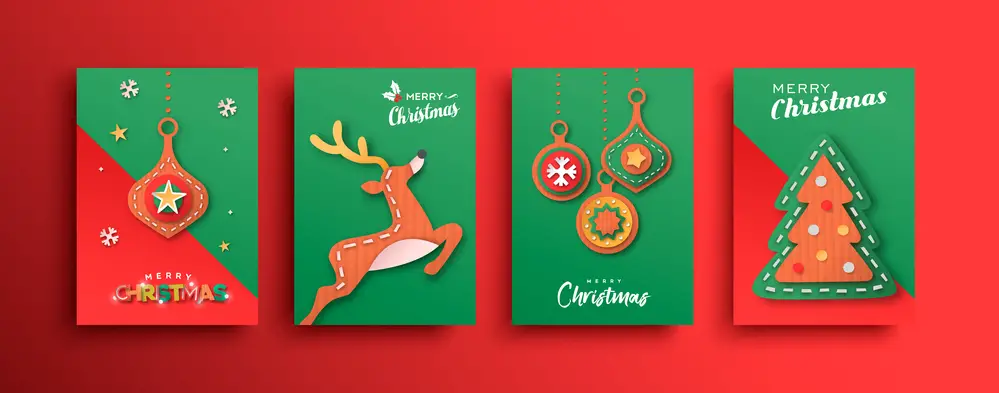According to a survey conducted by Greeting Card Universe, the average American will send and receive 30.7 greeting cards this year. As per reports by the Greeting Card Market Research, the greeting cards market in the U.S. was estimated at US$6.2 Billion in 2020. In 2022, the global greeting card industry stats is expected to reach US$ 7508.8 million due to the COVID-19 (Coronavirus) pandemic.
A complete evaluation of the business implications of the pandemic and its induced economic crisis has resulted in a revised CAGR of -2.5% for the Christmas/New Year segment for the next seven years. Greeting card sales and spending have increased over the years, but they’re still a tiny part of the average person’s budget. As a result, many have shifted to free online e-card sites too.
In fact, the greeting card industry stats only account for 0.3% of total consumer spending. However, greeting cards have been around for a long time and are not going anywhere. Greeting card and gift cards sales are expected to grow over the next five years.
10 Interesting Greeting Cards Industry Stats That You Should Know

Did you know that nine out of every ten households buy greeting cards each year in the USA? On average, Americans purchase approximately 6.5 billion greeting cards each year.
The idea of sending a card to say “thank you” or “I love you” isn’t going away anytime soon. The annual growth rate is getting bigger and bigger every year!
1. What is the average number of greeting cards sent per person in America each year?
As per the greeting card industry stats, a total of 6.5 billion greeting cards are purchased by Americans every year. Retail sales of greeting cards are estimated between $7 billion and $8 billion annually. In the United States, approximately 3 billion greeting cards are sent each year. In America, the average person sends about seven greeting cards a year.
2. What are the most popular occasions for sending greeting cards in America?
Card-sending habits in America have shifted dramatically over the last 75 years. In 1940, Americans sent an estimated 1 billion cards each year–that’s more than five per person on average. You must be wondering which holiday is the most popular to send cards? As per the greeting card industry stats, the most popular occasions for sending physical cards in America are birthdays, Valentine’s Day, and Christmas. The next-most-popular occasions as per industry trends are Mother’s Day, Father’s Day, anniversaries, and New Year’s Day.

The top five range of cards sold this holiday season, according to the National Retail Federation, a trade association for retailers in the United States, will be:
1. Birthday Cards (35 percent of total sales)
2. Get Well Cards (13 percent)
3. Season’s Greetings Cards (12 percent)
4. Thank You Cards (11 percent)
5. Sympathy/Mourning Cards (10 percent)
According to the NY Post, Valentine’s Day consumers spent an average of $164.76 each despite the pandemic disrupting the plans for many people.
3. What are the most popular greeting card brands in America?
According to a study by Hallmark Cards, the most popular greeting card brands in America are:
- Hallmark Cards, Inc. – 31.7%
- American Greetings – 18.4%
- Debbie Mumm – 5.8%
- Papyrus – 4.3%
- Bloomingdales 1-800 Flowers- 3.9%.
During this survey, they found that 54% of people surveyed said they had purchased a Hallmark card in the past year.
4. What is the average cost of a greeting card in America?
The average price of greeting cards in America is $3.47. This is not the case for every nation.
However, some countries have higher average prices than others because their currencies are worth more. As per the greeting card industry stats, a greeting card can be priced anywhere from 50 cents to more than $10 – with market trends and a price point to fit every budget. With online sales, the average price of online greeting cards can differ.

Typically, a greeting card costs between $2 and $5. The most expensive cards include intricate designs, special techniques, and new technologies and innovations, including sound chips or LED light strings. In addition, handmade cards are growing at the fastest rate.
For example, in the United Kingdom, a greeting card can cost as little as 50 pence (60 cents). The most expensive cards are found in Switzerland and Sweden: they average $7.50 and $6, respectively. This is more than any other country in the world.
5. What is the history of greeting cards in America?
The history of greeting cards in America is not as long. Greeting cards were introduced by artist Sir Henry Cole, who was inspired by the Japanese art form called “origami.” He developed a greeting card that was originally called “hand-pressed paper cards.”
In 1843, Sir Cole created the first Christmas cards, which he printed. The card featured a drawing of a family gathered around a Christmas tree and was designed to be sent as a greeting to friends and relatives. These were initially used as invitations to his dinner party. The cards were made with thick paper, and the printing was done by hand.
Over time, these cards became very popular in England and America. In fact, during the nineteenth century, greeting cards were sent to friends and family members on birthdays, anniversaries, weddings, and other special occasions. The first American-made Christmas card was produced in New York City in 1874. At that time, the cards were made by printing and coloring them manually. This was a prolonged process, but it was affordable for most people.
6. What are the environmental impacts of greeting cards in America?
As per greeting card industry stats, it was found that the average American will send 12.6 cards annually and receive approximately 7.3 from others each year. It means that Americans will send a staggering 1.8 billion greeting cards each year with no signs of slowing down.
What are the environmental impacts of this behavior? The average single cards weigh about 3.5 grams and are made from between 30 and 50% recycled paper. The average card will take about 12 months to decompose in a landfill, but because of the high percentage of recycled content, the process is much slower than that of a regular office paper.
7. What are the top greeting card trends in America?

A study by Hallmark found that 92% of those surveyed said they send everyday cards to express their feelings, and 83% said they sent cards because it’s a nice thing to do. The greeting card industry statistics show that the average number of greeting card purchases per year is 12, but the spending per person on greeting cards varies widely.
About one in five consumers (20%) spend less than $10 annually, while another 20% spend more than $100 annually.
8. What are some alternatives to traditional cards?
With regards to the greeting card industry stats, there are many options available to consumers who want to reduce their environmental impact. One of the most popular trends due to the COVID-19 Pandemic is the growth of online greeting cards. From everyday cards to wedding cards, seasonal cards to premium cards, the use of electronic greeting cards by American consumers has increased. These are sent via email and can be customized with a photo, video, or even song.
Online retailers have created attractive designs for greeting card buyers. In addition to traditional paper cards, there are other options available. For example, some essential retailers offer handmade card made from recycled materials or biodegradable products. This adds a personal touch to buying from online stores.
9. What are the most popular places to buy greeting cards in America?
The most popular retail space to buy holiday cards and seasonal greeting cards in America are brick-and-mortar stores, candy store, grocery stores, drugstores, and gas stations.
10. Is there an award to celebrate the best greeting card?

The Louie Awards celebrate the best cards annually. Since 1988, the International Greeting Cards Award Competition, or the Louies, has recognized the best cards. Louis Prang, a German immigrant who created one of the first Christmas cards in the United States, is credited with creating the Louies brand. The Louies are blind-judged on originality, design excellence, impact, value, and sensibility.
In May, the winners are announced in New York City during the National Stationery Show. For 2022, two cards received the highest honors as Cards of the Year 2022.
For the Card of the Year above $5, Seedlings won the best card award in the Sympathy category. For the Card of the Year under $5, Good Juju Ink won the best card award in the Friendship/Encouragement category.
Final Thoughts
The main thing that we learned from this research is how much people love sending and receiving greeting cards. On average, Americans spend $7 billion on greeting cards every year. In 2019, people sent over 1.2 billion greeting cards on Valentine’s Day. The greeting card industry stats are genuinely staggering and show that people love sending and receiving greeting cards. This is a trend that will continue for many years to come.
Thanks to digitalization, social media platforms, and messaging apps like WhatsApp, the greeting card business has been significantly affected. As people become more aware of the importance of saving trees, the demand for electronic cards has increased. Social media and e-cards continue to challenge physical greeting cards. However, there is still a consumer base for physical greeting cards, and giving and receiving these cards continues to matter to consumers. When celebrating special occasions, physical greeting cards mean a lot more than a message on Facebook or an e-card.







